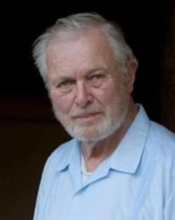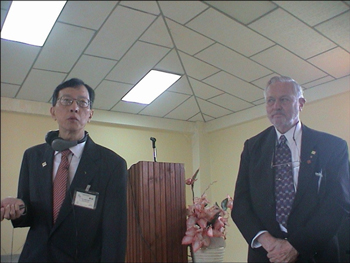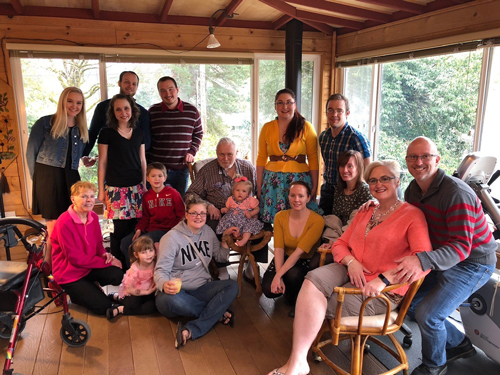- Membership
- In Memoriam
- Leslie Robert Atles
- Mario Castañeda
- David P. Harrington, PhD
- John Daniel Hughes, Jr.
- Al Grazutis Jakniunas
- George I. Johnston
- Robert L. Morris, PE, CCE
- Joel J. Nobel, MD
- Thomas Joseph O'Dea, PhD, CCE
- Marvin Dale Shepherd, PE, FACCE
- David A. Simmons, ScD, P.E., FACCE, CCE, CQE
|
|
|
|
Our Tribute to One of ACCE's Founders and Humanitarian
George I. Johnston, BSEE, MS, CCE, FACCE
May 29, 1929 - May 12, 2022

Clinical Engineer, humanitarian, and a founding father of the Clinical Engineering Profession
On Thursday May 12, 2022, George Johnston, devoted husband and loving father, grandfather and great-grandfather, passed away at the age of 92. George is survived by his wife Arlene, daughter Kimberly, son-in-law Andrew, step-daughter Kelley, step-son Steve, 19 grandchildren and 15 great grandchildren.
George's entry into the field of biomedical engineering came shortly after graduation from high school in 1948 when he got employment as a medical electronics technician at the Johns Hopkins School of Medicine. While working, he attended part time the Hopkins electrical engineering program and graduated in 1955. With his experience and new BSEE, George landed a job as a Biomedical Engineer at the Instrument Section of the National Institute of Health, where he authored his first publication and presented at two engineering conferences.
In 1958, George left NIH to start the Biomedical Engineering Support department at the University of Oregon Medical School (now Oregon Health Sciences University), which he modeled after the NIH's Instrument Section and JHU's School of Medicine Shop where he obtained his early experiences.
During the 1970s George's department of biomedical engineering like many others, experienced a significant shift in its customer base from a research focus to the hospital. Within 10 years, they became a hospital department and changed their name to Clinical Engineering! About that time, Project HOPE was introduced to George by Bob Morris. The overseas experiences were trying and a delight for both George and his wife, Arlene, so much that George retired from the University at the end of 1988. In 1989-1990, he took a long-term assignment with Project HOPE in China, and another long-term (1992-93) assignment in Guyana. After that, his humanitarian work took him to Belize, Guayaquil, Kenya, Kosovo, and beyond...
- BSEE Johns Hopkins University, 1955
- MS Applied Science, Portland State University, 1979
- Certification in Clinical Engineering, 1975
- ACCE founding member & ACCE Fellow member (first), 1999
- 1994: ACCE Professional Achievement Award, along with colleagues Gerald Goodman, John Webster & Albert Cook.
- 1996: article Problems, Perils, Precautions and Rewards in Overseas Clinical Engineering Training, JCE Vol 21, Issue 1.
- 2003: AAMI Foundation/ACCE Robert Morris Humanitarian Award
- 2005: ACCE Lifetime Achievement Award
- 2011: ACCE members video
I wanted to share a few things about my dad since we won't be gathering for a memorial. I came into my dad's life after my birth mother gave me up for adoption December 6th 1968. I lived the first 3 years of my life in the same home his wife Arlene Davis and George Johnston own today. My only memory of living there was the little pond in the back yard, at the time it felt massive and I do remember being scolded many times for getting to close. I was so shocked seeing it as an adult wondering why it was now so tiny funny how things just seemed so much bigger when we were little. I also remember the basement and pool table, not sure why that stood out so much to me, but the moment I walked into that room it just felt like home.
My dad and I became separated over a "complicated" divorce so we didn't see each other for many years other than occasionally in passing when Elise, my sister was picked up for visits. It wasn’t until 2010 I received a phone call and the voice said, "Kim I know this is really unexpected but this is your dad George, how have you been", instantly we started catching up and I could have talked for HOURS. We arranged to meet up at his home which looked exactly the same other than beautiful landscaping they had put in over the years, but the house was exactly the same even down to the Christmas lights still hanging under the Eves. It was like walking back in time. He asked me if I remembered where my room was and I said YES, I sure do and I led him right too it. Such an odd feeling standing in the room I had as a child and OH MY GOSH the stories he shared were amazing and hilarious and I think I needed to hear them, as much as he needed to share them.
Over Easter 2011 I asked my dad and Arlene to join our family in Maui to renew my wedding vows and asked my dad if he would walk me down the aisle, without hesitation he said "YES I wouldn’t miss it". That day is a day I will never forget. I felt like a princess and here was my dad, holding me close while walking down the aisle. Having the past 12 years to get to know my dad has been such a blessing to me, and I’m so grateful he picked up that phone that day and wanted to be a part of my life. Sharing my 7 beautiful children with him, all the crazy stories, the adventures, and just listening about his life and all the amazing places he has been, not to mention falling in love with his soul mate, and best friend and the perfect companion and wife Arlene. He truly lived a life very few will ever get to experience. He may have not been my dad by blood, but he loved me as his own and I will forever be grateful that I got to call him Dad. Kimberly Audova, daughter.
Our Colleagues Offer These Thoughts
____________________________________________________________________________________________________________________________________________
George was a very good friend and a prominent leader and mentor in the medical technology field. He was someone who was always ready to help his clinical engineering colleagues around the world. George was very committed to his work. On October 1, 2000 he traveled to Belize for a three-month assignment with PAHO and he and Arlene got stranded in Cancun for a week because of Hurricane Keith. He wanted to start his work as soon as possible knowing that Belize's hospitals were hit hard. He once said about the experience: "Arlene and I were delayed a week getting to Belize because of Hurricane Keith. However, we were stranded for that week in Cancun, which wasn't all bad, but a little boring after the first five days. Believe it or not, neither of us enjoys five-star hotel living for very long".
George was one of the originals – truly original in providing support for OHSU from the research side and then moving into clinical. On his own initiative he compiled a history of Clinical Engineering. I found this: Ridgway, M. G., G. I. Johnston, and J. P. McClain. History of engineering and technology in healthcare, in Dyro, J. ed. Clinical Engineering Handbook.2004. Perhaps not as well known is that he pursued a PhD and selected as the dissertation subject gathering data from some number of hospital CE departments and comparing the data. I confess to trying to talk him out of this, skeptical of getting good numbers and, now searching Google see that Binseng cited George's article asking the question of whether it was possible. Binseng's: CLINICAL ENGINEERING BENCHMARKING: A Preliminary Analysis of Clinical Engineering Data in American General Acute-Care Hospitals 2006.
In 2005 I need to have someone cover the Biomed shop up here in the NWT for 3 months. He and Arlene were all in on the idea of coming up here for the summer. Sadly, the work visa fell through! The Government forced me to do a job interview so I got a kick out of getting to interview a nervous George Johnston since he confessed, he hadn't done a job interview in 50 years. It was also wild having someone answer technical questions with statements like "well when I helped design the first....". Getting to do that job interview is one of the highlights of my career!
George Johnston should be considered one of clinical engineering’s
“Founding Fathers” – one of that small band of brothers who pioneered the concept
of dedicated on-site biomed specialists to take care of the safety and
maintenance requirements of the hospital’s diagnostic and monitoring equipment
– a concept that is today known as the biomedical or clinical engineering
department. Prior to this new type of department, individuals who had technical
instrumentation know-how were considered instrument makers and generally
supported by research funds obtained by members of the hospital’s medical
staff. Such individuals were rare and
generally found only in the larger teaching hospitals.
I first met
George during the early years when we were wrestling with the various
standards-making organizations to get concern about patient safety into a proper
perspective and to establish practical professional representation and training
programs such as those sponsored by the ACCE. It was an important and
interesting time. He had come up through the traditional route, spending seven
years as an instrument designer and fabricator at Johns Hopkins University
Medical School, and three years at the National Institutes of Health rubbing
shoulders with some of the big names in early biomedical instrument design before
founding the biomedical engineering department at the University of Oregon
Medical School in 1983. George Johnston was a significant and thoughtful
contributor to a very important professional initiative. He was a good friend. I value his
contributions and I will miss him.
Malcolm Ridgway
______________________________________________________________________________________________________________________________________________
My interactions with George showed me a man of deep conviction and passion for our profession and especially for the people we ultimately serve - the patients. It goes without saying that he had energy that belied his years, always friendly, open to new ideas and a real gentleman. I have enjoyed filling in the blanks through your eyes, wish I had known George better, but will miss him, nonetheless.
Ray Zambuto
______________________________________________________________________________________________________________________________________________
George was a gentleman, a dedicated, brilliant, and generous CE, and was one of those people who was always welcome in any setting. Rest in Peace, George.
Elliot Sloane
______________________________________________________________________________________________________________________________________________
This is indeed sad news. George was a special kind of engineer. Like his friend and collaborator of many years, Bob Morris, George believed in basic engineering principles. When Bob Morris wrote in 1985 a lecture outline for teaching troubleshooting methods, George edited it and inserted a section he called "Don't add to your problems." When I expressed my amazement, in the summer of 2014, of the magnitude of the material pertinency after about 30 years, George responded: "Yadin, it is mostly fundamentals and fundamentals don't go out of date."
Yadin David
______________________________________________________________________________________________________________________________________________
I first met George in the late 1980's when I came to the US occasionally for some conferences while still working in Brazil. At that time, he was already mostly retired, having left the OSHU leadership to Bob Morris and was volunteering overseas. He was always very kind and generous with his time and advice, willing to share his experiences in China and other developing countries. I was amazed that he (and, especially, his wife Arlene) was willing to go to less developed and potentially dangerous places to help and guide younger persons. Later on, I discovered that he actually pioneered at some organizations that later I had the privilege of either working for (e.g., the Biomedical Engineering and Instrumentation Program at NIH) or visiting (e.g., the Biomedical Engineering Department headed by Bob Stiefel for many years). He serves as a great example of how clinical engineering professionals interested in assisting less developed countries should behave, i.e., provide solid technology solutions compatible with the local reality, while maintaining an open mind to different cultures and beliefs and, above all, avoid imposing complex and costly rules and practices that provide insignificant benefit for the patients.
Binseng Wang
___________________________________________________________________________________________________________________________________________
George Johnston Clinical Engineer Extraordinary
George is one of the few persons in the Clinical Engineering field longer than me. Like me he came out of the Hospital Research Field. We got to know each other in AAMI and both were certified in the initial group there. I learned a lot of practical clinical engineering from George. He got me involved with training people in China around 1990. He trained in more remote places than most of the rest of us. I remember him discussing that he had to go by canoe in Guyana to get to the training site. I worked with him in China and especially in Africa. The last training that I did with him was in Kenya in 2009. He had a lot of leg problems but was still willing to go a long distance to train people on Clinical Engineering Management. He was very down to earth and practical with his training. I will always remember my experiences with George.
James Wear
___________________________________________________________________________________________________________________________________________
George a partner, mentor, friend, soldier for many years for CE. An encourager and partner to Bob Morris (and many others of us), a mentor to many ACCE ACEW faculty and students in Africa, Europe and Latin America, a friend to many CE colleagues, and such a soldier for CE that he accepted extended overseas assignments in his 80s. Listen to his calm voice on the ACCE Elder video from 2011 (link above) talking about his career and how we CEs make a difference!
Tom Judd
___________________________________________________________________________________________________________________________________________
George was one of my mentors. He always had time for young, wet-behind-the-ears engineers like me. That's a debt I try to pay forward to the next generation. George got me started in forensic engineering for medical device-related incidents. I was reluctant at first -- Who wants to deal with lawyers and the adversarial legal system? -- but he convinced me to give it a try on one of his cases. I loved the challenge of getting to root causes and bringing scientific and engineering rigor to the legal process. I've now been doing that sort of work for more than twenty-five years.
Matt Baretich
___________________________________________________________________________________________________________________________________________
George Johnston was one of the few clinical engineering free spirits. When he was young enough to need a real job in clinical engineering, he worked at OHSU Medical Center in Oregon. The catch here was that he worked with Bob Morris, the other free spirit of that generation and they took turns covering for each other as one or the other traveled around the world helping others. George was an outstanding clinical engineer, technician, manager, teacher, visionary, administrator, friend, husband and father (not in that order). But, every time a clinical engineering opportunity came up, particularly if it was in an interesting place, George (and Arlene) said "Yes" and off they went for 3 months, 6 months, 1 year or 2 years. They enjoyed life in the field of clinical engineering as they helped people and healthcare systems all over the globe.
George will be remembered. George will be missed. But most of all George has set a standard on how you can be yourself, do what you want to do, be useful and helpful, and be free, all under the wing of clinical engineering.
Frank Painter
___________________________________________________________________________________________________________________________________________
George was such a character! I always enjoyed hearing his stories of the start of Clinical Engineering. He led such a wonderful life and will truly be missed yet fondly remembered.
Jennifer Ott
---------------------------------------------------------------------------------------------------------------------------------------------------------------------------------------------------------------------------------------
George was a big proponent of Clinical Engineering in China at a time when it was completely unkown at the hospital level. He was also kind to my wife Cindy and I by taking some VHS tapes in 1989 of our newly adopted daughter from Shanghai. It was the first time our parents saw their grandchild.
Robyn Frick
___________________________________________________________________________________________________________________________________________
 PAHO’s Belize Mission – October 10, 2000 PAHO’s Belize Mission – October 10, 2000
 ACEW Prishtina, Kosovo - June 6-7, 2006 ACEW Prishtina, Kosovo - June 6-7, 2006

ACEW Guayaquil, Ecuador – September 9-13, 2002

ACEW Prishtina, Kosovo, 2004

George and Arlene

George, Arlene and daughter Kim+family
|
|
|
| |
| |
|
|
| |
|